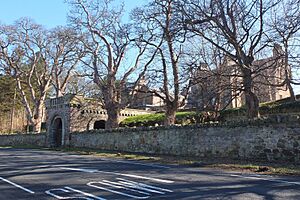Luffness Castle facts for kids
Luffness Castle, also known as Luffness House, is a historic building. It is located near the village of Aberlady in East Lothian, Scotland. This house was built inside what used to be a strong castle.
A Look Back in Time
The land around Luffness House once belonged to the Earls of Dunbar and March. In the 1100s, it was given to the Lindsay family. They built a large and strong castle here in the 1200s.
Some land was given to the Church in 1256. This was to remember Sir David Lindsay. He was a very important person in Scotland. Sir David died while on a religious journey. He had promised to give land for a religious house if his body was brought back to Scotland.
A friary, a type of religious house, was built nearby in 1293. It was for a group called the Carmelites. You can still see parts of this old friary hidden in the woods today.
In 1311, King Edward I and his English army took over the castle. Later, in 1547, an English force led by Lord Clinton attacked and damaged it.
French soldiers helped the Scots in 1549. They built a fort at Luffness. This fort was meant to stop English supplies going to their fort in Haddington. However, the Queen of Scotland, Marie de Guise, ordered this fort to be taken down in 1552.
In the late 1500s, the Hepburn Earls of Bothwell owned Luffness. They rebuilt the castle. Later, in the 1600s, the Durham family took over. An Adam Duff of Luffness is also mentioned in 1704.
In 1739, the Hope Earl of Hopetoun bought Luffness. The castle was changed and made bigger in 1822 by William Burn. More work was done in 1846 and 1874 by David Bryce. Today, the house is kept in good condition. The Hope family still lives there.
What Luffness House Looks Like
Luffness House today is a three-story building. It has an attic and looks like the letter "T". A square tower forms the main part of the "T" shape.
Inside, there is a special spiral staircase called a turnpike stair. It goes up the first two floors. A historian named Nigel Tranter believed this staircase might be what is left of the original 1200s castle.
The house stands at the northwest corner of an old square fort. This fort is marked by a ditch that is partly filled in. This ditch might be from the French fort built in 1549. Or, it could be from the even older castle.
Images for kids



